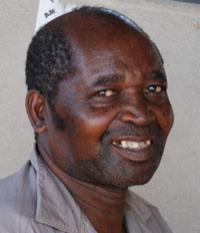
Malaba
Agustino Malaba is one of the most known Makonde masters. He is the holder of the prestigious Zeze award which is given annually to the best artists in Tanzania. But his biggest contribution to Tanzanian art was to create the huge non-informal artist network in Tanzania. Since 1972 when he came to Dar es Salaam from Mchauru Mwitika (Newala region in South Tanzania) he invited huge number of artists to follow him to pursue the art in the big city. Unbelievably it was him who took George Lilanga, one of the most famous African artists and Robino Ntila, the manager of Cultural House to Dar es Salaam in around 1974. Other artists were: Hedrick Likonde, Costa Ilali, Thomas Ntundu, Adija Sulutani, Peter Kalulu, Nyedi Dastani, Andrea Okoti, Hendrick Madebe, Anton Mwamba etc.
His starting point in his art carrier was the significant meeting in 1973 with the American Sister Jean Pruitt who is known in Tanzania mostly for the opening of the Dogodogo Children Center. At that time she organized the artists to collectively work in artist workshop. One year later in 1974 Agustino Malaba moved to a collective house in Upanga with Sister Jean and Mary Rose together with other artists: Raza Mohammed, Juma, Kasian Msola, Oriyo Vincent. Later came to the collective house Robino Ntila, Salum Thulutani, Thobias Mavona and more. Every day at morning the artists went to Samora Avenue to work with art. They were not only sculptors and painters but people making batiks, beads etc. That was basis for the modern Nyumba ya Sanaa (Cultural House).
At that time in 70┬┤s Agustino Malaba was sculpting different designs, not only Shetani. He did also calabas, painted on goatskin, batiks, woodcut, linocut. Since this group of artists got attention, much to thanks to sister Jean Pruitt, there were a number of opportunities to visit foreign countries. Malaba┬┤s first international trip was to Sweden in 1976. He went with Kasian Msola and Mr Wangura from Ministry of Culture. Surprisingly Mzee Malaba showed not only his art but also joined the musical group. He is a great drummer and until now he is a leader of a Makonde dance group in Mbagala, Dar es Salaam. The second trip was to East Germany which was the same. The third trip was to Italy in order to sculpt a door in 1978. But Mr. Malaba he got many more invitation but the problem was financing.
The most interesting is though the connection Malaba has to Lilanga art. In fact it was him who carved all Lilanga sculptures (and his helpers), Lilanga did not know how to carve the fingers on the Lilanga figures, for instance. At the time when Malaba, Lilanga┬┤s uncle stayed in the collective house with Sister Jean, George Lilanga himself lived in Mosko, Kinondoni in Dar es Salaam. It was again Mr. Malaba who invited him to the artists group. First George Lilanga was just a watchman and in the free time he was painting (on batiks, screen etc.).
So Mr Malaba and Mr.Lilanga has worked many years together before George Lilanga became famous. It was due to a number of exhibitions abroad. Somehow the group (Mr Malaba. Mr. Kapanda and Mr.Lilanga) decided that all art works would be signed as Lilanga. George Lilanga only sketched, he did not paint and he did not sculptor the Lilanga art. It was Noel Kapanda and Agustino Malaba. (The research is still continuining and detailed explanations will be published in future)
Gradually when the art became increasingly popular and many orders came from art dealers Mr.Malaba was not able to supply the figures to George Lilanga. His studio was slowly growing. Among the artists in Malaba studio were his son Vinta Malaba, Costa Ilali (Kapelo), Thobias Steven, Francis Regan, Thomas January and many more. His studio is quite known in Tanzania and was visited by Tanzanian officials as well as by many art lovers. Suprisingly ÔÇô the biggest art dealers with Lilanga art did not visit him.








